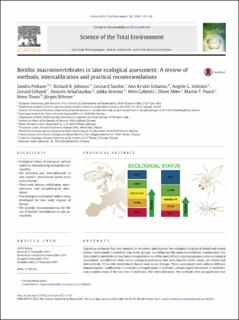| dc.contributor.author | Poikane, Sandra | |
| dc.contributor.author | Johnson, Richard K. | |
| dc.contributor.author | Sandin, Leonard | |
| dc.contributor.author | Schartau, Ann Kristin | |
| dc.contributor.author | Solimini, Angelo G. | |
| dc.contributor.author | Urbanic, Gorazd | |
| dc.contributor.author | Arbačiauskas, Kęstutis | |
| dc.contributor.author | Aroviita, Jukka | |
| dc.contributor.author | Gabriels, Wim | |
| dc.contributor.author | Miler, Oliver | |
| dc.contributor.author | Pusch, Martin T. | |
| dc.contributor.author | Tim, Henn | |
| dc.contributor.author | Böhmer, Jürgen | |
| dc.coverage.spatial | Europe | en_US |
| dc.date.accessioned | 2023-03-15T08:06:31Z | |
| dc.date.available | 2023-03-15T08:06:31Z | |
| dc.date.created | 2017-02-23T10:43:28Z | |
| dc.date.issued | 2016 | |
| dc.identifier.citation | Science of the Total Environment. 2016, 543 123-134. | en_US |
| dc.identifier.issn | 0048-9697 | |
| dc.identifier.uri | https://hdl.handle.net/11250/3058266 | |
| dc.description.abstract | Legislation in Europe has been adopted to determine and improve the ecological integrity of inland and coastal waters. Assessment is based on four biotic groups, including benthic macroinvertebrate communities. For lakes, benthic invertebrates have been recognized as one of the most difficult organism groups to use in ecological assessment, and hitherto their use in ecological assessment has been limited. In this study, we review and intercalibrate 13 benthic invertebrate-based tools across Europe. These assessment tools address different human impacts: acidification (3 methods), eutrophication (3 methods), morphological alterations (2 methods), and a combination of the last two (5 methods). For intercalibration, the methods were grouped into four intercalibration groups, according to the habitat sampled and putative pressure. Boundaries of the ‘good ecological status’ were compared and harmonized using direct or indirect comparison approaches. To enable indirect comparison of the methods, three common pressure indices and two common biological multimetric indices were developed for larger geographical areas. Additionally, we identified the best-performing methods based on their responsiveness to different human impacts. Based on these experiences, we provide practical recommendations for the development and harmonization of benthic invertebrate assessment methods in lakes and similar habitats. | en_US |
| dc.language.iso | eng | en_US |
| dc.rights | Attribution-NonCommercial-NoDerivatives 4.0 Internasjonal | * |
| dc.rights.uri | http://creativecommons.org/licenses/by-nc-nd/4.0/deed.no | * |
| dc.subject | Biological metrics | en_US |
| dc.subject | Benthic invertebrates | en_US |
| dc.subject | Ecological assessment | en_US |
| dc.subject | Lakes | en_US |
| dc.subject | Water Framework Directive | en_US |
| dc.subject | Pressure–response relationships | en_US |
| dc.title | Benthic macroinvertebrates in lake ecological assessment: A review of methods, intercalibration and practical recommendations | en_US |
| dc.type | Peer reviewed | en_US |
| dc.type | Journal article | en_US |
| dc.description.version | publishedVersion | en_US |
| dc.rights.holder | © 2015 The Authors | en_US |
| dc.subject.nsi | VDP::Matematikk og Naturvitenskap: 400::Zoologiske og botaniske fag: 480 | en_US |
| dc.source.pagenumber | 123-134 | en_US |
| dc.source.volume | 543 | en_US |
| dc.source.journal | Science of the Total Environment | en_US |
| dc.identifier.doi | 10.1016/j.scitotenv.2015.11.021 | |
| dc.identifier.cristin | 1453329 | |
| cristin.unitcode | 7511,6,0,0 | |
| cristin.unitname | Oslo | |
| cristin.ispublished | true | |
| cristin.fulltext | original | |
| cristin.qualitycode | 2 | |

